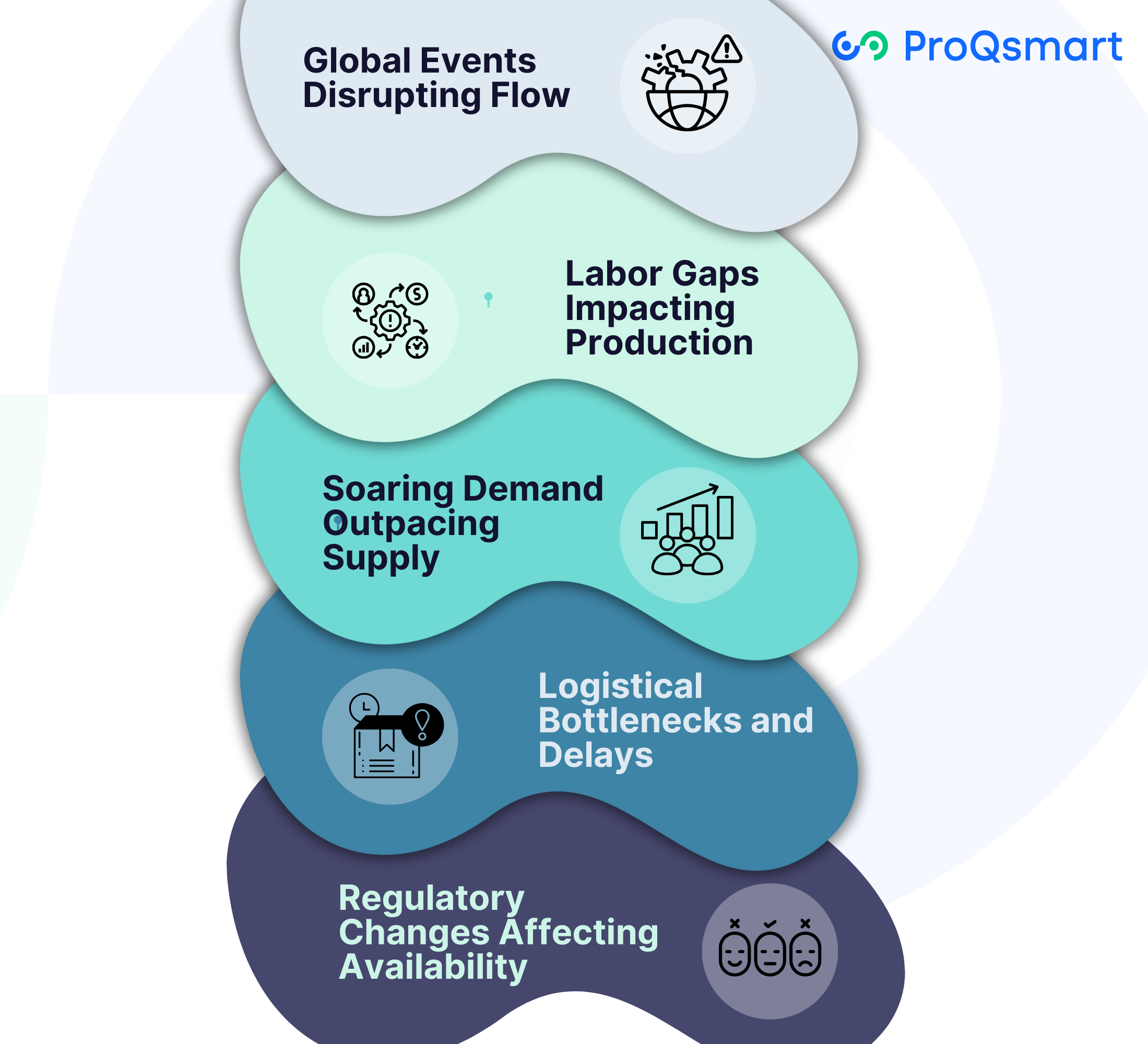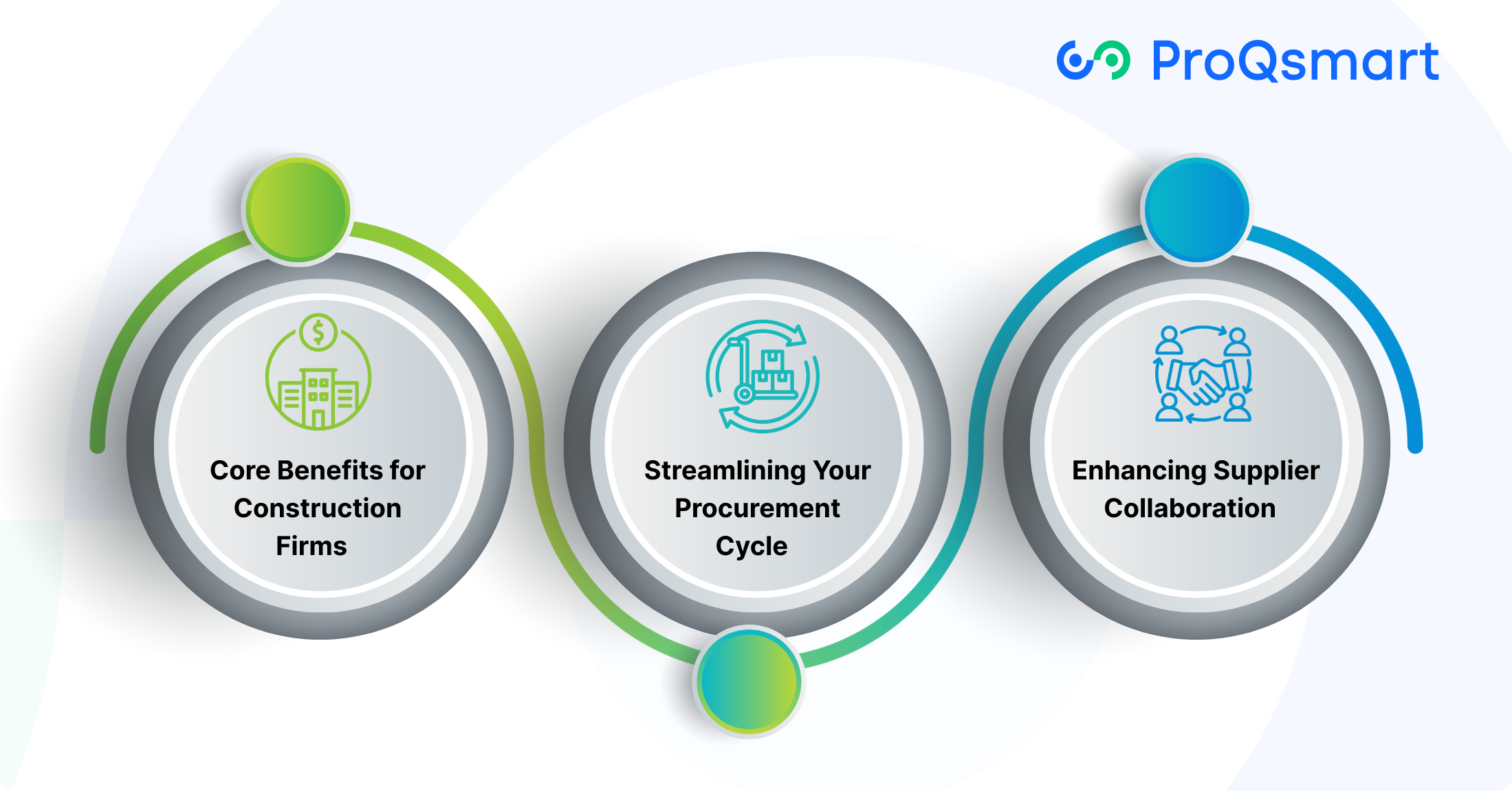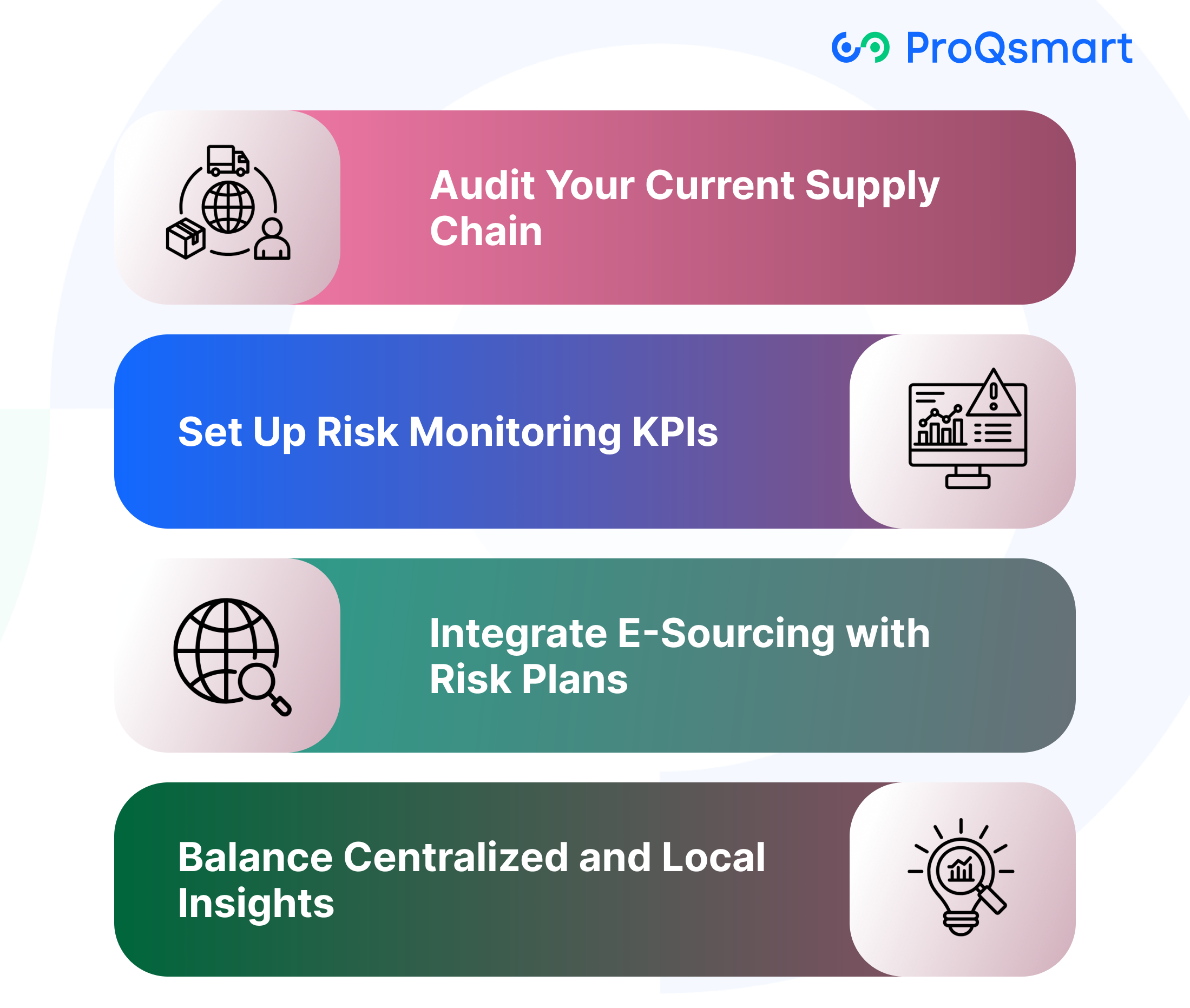Material shortages in the construction industry, driven by global supply chain disruptions, labor constraints, and volatile raw material availability, are causing significant project delays and cost escalations. These disruptions challenge traditional procurement methods, which often lack the agility to anticipate and address supply risks effectively.
E-sourcing platforms like ProQsmart empower construction teams to predict and mitigate these risks by leveraging real-time data and predictive analytics. By monitoring supplier performance, tracking material availability, and analyzing market trends, these tools enable proactive decision-making to secure critical supplies.
The following sections explore how ProQsmart’s intelligent e-sourcing capabilities help construction firms anticipate supply chain vulnerabilities, maintain project schedules, and achieve cost stability.
Unpacking Material Shortage Triggers

Triggers for material shortages in construction rarely come down to one reason. Often, it’s a combination of external, internal, and local elements. Supply chains are only as strong as their most complex web, so one weak link can create cascading issues across the supply chain.
Here’s what you need to know about these triggers to help your agency’s leaders better manage risk and ensure your projects stay on schedule.
1. Global Events Disrupting Flow
Global events can abruptly disrupt the flow of construction materials, creating supply chain vulnerabilities. Geopolitical tensions and trade policy shifts, such as tariffs or sanctions, drive up costs and restrict access to critical resources like steel, aluminum, and cement. Natural disasters and labor disruptions further exacerbate shortages, delaying projects and inflating budgets.
These unpredictable events expose the limitations of traditional procurement, which struggles to adapt quickly. E-sourcing platforms like ProQsmart address these challenges by providing real-time market insights, supplier diversification, and predictive analytics to anticipate disruptions and secure stable material supplies.
2. Labor Gaps Impacting Production
Shortages in labor increase time to production and result in increased costs. As with any products, when there’s a shortage of skilled workers, the lead times increase and budgets are tested.
It’s hard for anyone to predict when construction timelines start to slip with crews not at full strength. While some firms have begun hiring their own workers by investing in training or automation to offset the loss, the labor gap continues to be the industry’s biggest threat.
3. Soaring Demand Outpacing Supply
Demand for building materials can increase quickly—particularly once new residential or large-scale construction starts are jumping. Supply chains are struggling to catch up, causing prices to spike.
Companies must adopt more sophisticated sourcing strategies and work with more adaptable suppliers to stay ahead.
4. Logistical Bottlenecks and Delays
Another ongoing issue is moving materials. Congested ports, truck shortages, and overall shipping delays have created another challenge of maintaining timely deliveries of materials.
When one link in the chain stops, it becomes a domino effect and the entire system comes to a crawl. Even with solid logistics management, risks remain elevated.
5. Regulatory Changes Affecting Availability
New, abrupt regulations on trade, safety, or environmental protection can suddenly disrupt established supply lines. Compliance becomes a major consideration when selecting suppliers and sourcing materials.
By keeping track of these rules, elected leaders may be able to prevent a last-minute shock to the system.
Old Procurement: Falling Short
Old processes—grounded in outdated, labor-intensive methods—frequently have teams waiting on equipment, in some cases for days. Delays of 48-72 hours or longer are routine, and paper-based tendering can stretch out for months.
These gaps have a tangible impact on efficiency and can even halt production lines at the exact moment customers require outcomes.
Why Traditional Methods Falter
Conventional procurement is based on old habits. It is severely lacking in speed and foresight to identify risks across the supply chain early on. For the majority, they’re still doing it in spreadsheets or other siloed systems. This dependence complicates their ability to pinpoint a material shortage before it’s too late.
Without a true data exchange, decisions are educated guesses at the very highest level. In high-velocity markets like today’s, this inability to be nimble leaves firms at a disadvantage, always on their heels, responding rather than proactively anticipating.
The Pitfalls of Single Sourcing
Even today, a lot of companies continue to rely on a single supplier for critical components. This seems straightforward on the surface but sets them up to be vulnerable. If that partner stumbles—whether it’s a sudden bankruptcy or raw material shortage—the entire project comes to a standstill.
Single sourcing has even resulted in weeks-long delays in some instances. This has delayed launches and cost teams millions in overtime and late penalties. Expanding the supplier pipeline is one way to avoid all of these pitfalls and ensure projects stay timely.
Lack of Real-Time Data Blindness
Without this real-time visibility, teams are blind to issues until after they have already occurred. This lack of real-time data, referred to as “data blindness,” leads to missed warning signs, bad calls, and lost savings.
With tools available today, contracting officers have access to dashboards and alerts that illustrate where gaps or risks exist in real-time. Incorporating these tools enables teams to detect issues sooner and respond more quickly to mitigate impacts.
Manual Processes Slowing You Down
Manual processes make it hard for you to move fast. Chasing down approvals, sorting paperwork, and re-keying details consumes valuable hours. This extends schedules, increases expenses, and opens the door to errors.
Automated tools eliminate these bottlenecks, reduce mistakes, and free teams to focus on what’s important.
E-Sourcing: A Smarter Approach

E-sourcing is the cornerstone of a more intelligent procurement strategy, providing construction companies with powerful, data-driven methods for controlling supply-side risk. E-sourcing platforms help teams centralize their work by storing documents, tracking goods and services in a single platform, and pre-qualifying suppliers. They liberate people from the former practice of following spreadsheets around and digging through inboxes.
The move to e-sourcing is giving firms the ability to leverage solutions that are interconnected through the IoT and blockchain. This integration simplifies tracking consignments, verifying sources of supply, and upholding transparency requirements!
Core Benefits for Construction Firms
E-sourcing has become common practice for many construction teams, as it saves time and money. These platforms allow companies to create robust RFQs, evaluate bids, and conduct e-negotiations all in one place.
They offer a formidable advantage in choosing optimal terms. Firms have the opportunity to choose Sole, Single, or Multiple Supplier approaches depending on their requirements. When teams use e-sourcing, suppliers compete on a level field, which sharpens pricing and lets everyone see the terms up front. The ultimate outcome is bottom-line cost savings and mutually beneficial supplier relationships.
Streamlining Your Procurement Cycle
An end-to-end, automated procurement cycle with e-sourcing eliminates many steps that prolonged the process for weeks. Actions such as archiving documents, distributing specifications, and reviewing supplier history can now be done within minutes. Automation translates to less lead time, reduced human error, and more time for teams to invest in strategic initiatives.
Evaluating and adjusting methods for supplier selection prevents the process from going stale. This proactive approach ensures that firms are prepared to stay ahead of the market as it evolves.
Enhancing Supplier Collaboration
Most e-sourcing platforms offer chat, document sharing, and feedback tools that help create a more collaborative, easy experience for suppliers. Teams can establish collaborative reviews, exchange immediate feedback, and resolve issues quickly.
When all parties work off the same data, it not only helps identify potential risks sooner, but helps establish transparency and trust. This has the effect of making suppliers—and everyone else—feel like real partners and not just vendors, further strengthening the entire supply chain.
How E-Sourcing Predicts Supply Risks
E-sourcing platforms have become the operating system for predicting and managing supply risks across custom manufacturing. They apply advanced data-driven methodologies to enable teams to identify problems before they impact the project schedule or cost. From this data alone, these platforms provide deep, predictive insights into supplier reliability, market fluctuations, and sourcing/cost risk.
Grounded in historical data, e-sourcing empowers procurement teams to make informed decisions and stand firm when the going gets rough.
Using Data to Forecast Shortages
A good e-sourcing tool pulls from real-time supplier data, past order records, and market shifts to spot possible shortages. Historical data, like past delivery delays or price jumps, shows where risks might pop up again. This only works if the data is right.
Clean, up-to-date info means teams can act early and avoid scrambling for parts when supplies run thin. For example, detailed RFQs let buyers judge supplier strength and spot risks before signing deals.
Advanced Analytics for Market Insights
E-sourcing platforms, with their built-in analytics, can help to illuminate market trends and highlight where supply challenges may begin. Now, teams can monitor raw material price inflation, sudden shifts in demand, or potential supply chain choke points.
That’s why smart market intelligence can keep teams one step ahead, allowing them to change course before potential risks develop into actual financial losses. This leads to good decision-making that’s informed by real-time data.
Diversifying Suppliers Proactively
Innovative teams actively leverage e-sourcing to maintain a diverse supplier base. By keeping tabs on multiple suppliers at once, they prevent the hurt caused by their suppliers’ failure. Staying ahead with multiple suppliers protects against risk.
Maintaining options is critical, particularly when demand suddenly changes or supply is interrupted. This strategy allows their production lines to continue to run, despite a very difficult market.
Real-Time Alerts for Price Spikes
Real-time alerts for price spikes E-sourcing tools can help procurement teams proactively flag price increases in real time. Teams get real-time notifications.
This empowers them to purchase supply before prices spike or secure their purchases when prices are at their lowest. This prevents surprise budget overages and ensures transparent spending.
How Quality Data Fuels Prediction
Quality data fuels prediction Accurate, quality data is the bedrock of risk prediction. When data is clean, accurate, and validated, teams can have confidence in their forecasts and develop plans that stand the test of time.
Robust data practices such as regular data supplier verification processes and digital supply chain documentation reduce human error and the risk of overlooked risks.
Tools like ProQsmart, for instance, are infusing AI-driven insights into the procurement process. It ensures quality metrics are implemented with supplier performance tracking, bid management, and workflow automation to easily and clearly predict risk and enforce compliance across teams.
Implement E-Sourcing Effectively

By implementing e-sourcing effectively, businesses can mitigate supply risks by improving the transparency, efficiency, and data-driven nature of their sourcing processes. By implementing their own proven digital tools, companies can react to supply risks with greater speed and a more decisive mindset.
It’s a process that produces results most effectively when it is aligned with the company’s broader objectives and continues to adapt as the market demands.
Audit Your Current Supply Chain
So companies should begin with an honest audit. That’s everything from supplier performance, lead times, contract terms, compliance and backup options – checking every link in the chain.
An effective checklist goes beyond supplier risk profiles to include contract expiration dates, risks by geography and current cost. Audits help identify areas where your procurement processes are falling behind, such as slow RFQ cycles or lack of supplier vetting and controls.
Identifying these gaps allows teams to focus on all aspects of their procurement strategy and prioritize their e-sourcing efforts properly.
Set Up Risk Monitoring KPIs
Monitoring supply risks requires appropriate KPIs. Supplier on-time metrics, contract compliance rates, price variations, or response time on incidents … these are all important metrics.
Establishing these KPI alongside regular check ins allows teams to identify problems before they become too serious. The majority of organizations use weighted scoring models to objectively score bids/finalists, and e-sourcing software has made these reviews virtually seamless.
Integrate E-Sourcing with Risk Plans
Integrating e-sourcing with risk management plans provides a more comprehensive perspective. Connecting sourcing tools with risk dashboards enables teams to respond quickly and ensure that procurement continues to support broader business objectives.
ProQsmart uses AI to do a lot of grunt work for RFQs, creating documents and automating them. It provides real-time insights into supplier performance—so compliance and transparency are never an afterthought.
Balance Centralized and Local Insights
We have seen the greatest success when our centralized teams collaborate closely with local subject matter experts. Local teams will be more familiar with market quirks, supply bottlenecks or emerging risks that a central team won’t catch.
E-sourcing platforms facilitate this with features that maintain workflows and data in plain view to everyone involved, helping teams work collaboratively and source more strategically.
Conclusion
E-sourcing equips construction teams with advanced tools to proactively manage supply chain risks and maintain project momentum. By leveraging platforms like ProQsmart, procurement professionals can identify potential disruptions, compare supplier proposals in real time, and secure materials before shortages escalate. Replacing inefficient manual processes, e-sourcing delivers transparent data on lead times, cost fluctuations, and supplier reliability, empowering teams to make informed decisions swiftly. This ensures resilience against market volatility and supports cost stability. To strengthen your supply chain and safeguard construction projects, explore ProQsmart’s capabilities by scheduling a tailored demo today.




